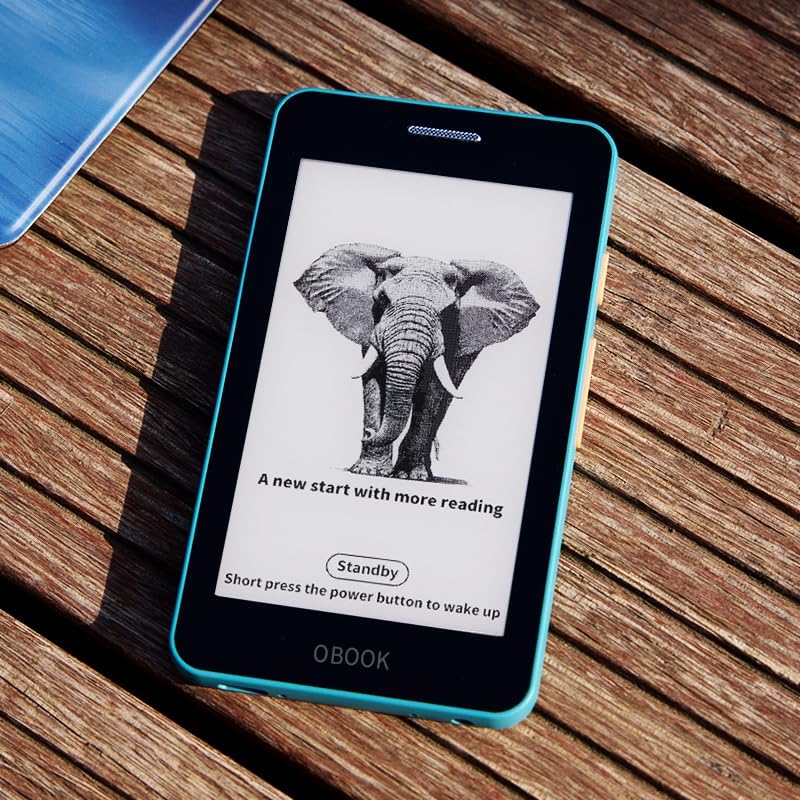A Chinese manufacturer has quietly listed a new pocketable e-reader on Amazon – the OBOOK 5 mini e-reader. It’s a curious device: compact, low-cost, and possibly built from parts intended for DIY projects.
What the OBOOK 5 Mini e-reader listing reveal
From the Amazon listing (and summarised by Nathan at The eBook Reader Blog), we have these reported specs of the OBOOK 5 Mini e-reader:
- Screen size: 4.26-inch e-paper display.
- Resolution: 800 × 480, which translates to about 219 PPI.
- Grayscale levels: the listing says ‘4 levels of grayscale’, which is strange as e-paper displays typically offer 16 levels of grayscale.
- Storage: 32 GB, which is decent.
- Battery: 1,200 mAh.
- Connectivity: Wi-Fi (2.4 GHz).
- Physical buttons: volume buttons that may double as page-turn buttons.
- Weight & dimensions: claimed 94 g; size 125 × 70 × 8.25 mm.
- Interface/ports: USB-C.
- Supported formats: TXT, EPUB, MP3, MOBI, DOC, FB2, HTM/HTML, AZW3, PRC, RTF, TCR, CHM.
- Audio: built-in speaker plus 3.5 mm headphone jack.
- Listing price: USD 109.99 with Amazon shipping and 30-day return eligibility.
Nathan (in his blog post) raises several red flags about the OBOOK 5 Mini e-Reader:
- The “4 levels of grayscale” is very low and atypical, as most E Ink displays support 16 levels or more.
- He suggests the display might be a Waveshare e-paper module, the same as those used for Raspberry Pi / hobby projects, repurposed into a consumer device.
- The software is likely very basic, and there is doubt about DRM support (i.e., it may fail to open many protected e-books).
- He notes that obscure Chinese imports often suffer from reliability, firmware updates, support, and part failures over time.
So, while some specs are intriguing, there is reason to be cautious.
Inconsistencies & unknowns
- The listing does not specify the exact display technology (e.g. E Ink, Carta, Pearl). Instead, it is only the term ‘e-paper’ that has been used.
- The ‘4 grayscale levels’ claim itself is suspicious. Real e-ink readers nowadays use 16 or 32 shades (or more).
- If indeed a Waveshare / hobby display is used, that implies compromises in refresh speed, contrast, ghosting, and durability.
- There is no mention of refresh modes, firmware, OS, update support, or long-term usability.
Because of these, it’s unclear whether the OBOOK 5 mini e-reader is a serious competitor or just a novelty gadget.
Where this fits in the ‘smartphone-shaped e-reader’ lineage
The concept of an e-reader shaped like a smartphone is not new. The Boox Palma is a well-known example: a 6.13-inch device with Android + Google Play + E Ink screen that more closely mimics a phone in form factor.
Before that, there had been a few attempts:
- YotaPhone (Russia) had a rear E Ink panel behind a conventional smartphone.
- Some small e-reader makers in China experimented with compact e-ink devices in phone form factors.
- The Boox Palma helped popularise the concept of pocketable e-reader devices shaped like a smartphone.
The OBOOK 5 could be seen as a more barebones, low-cost experiment in that direction.
Pros & Cons (based on the blog’s analysis + listing data)
Pros/appealing features
- Very compact size and light weight (94 g claimed), which makes it more portable than full 6-inch e-readers.
- Relatively generous storage (32 GB) for a small device.
- USB-C port, volume/page buttons, and headphone jack are nice touches.
- Multipurpose: supports audio + e-book.
- Price is modest compared to premium e-ink readers.
Cons/risks
- Display quality concerns: only 4 levels of grayscale are extremely low; contrast, ghosting, and readability are likely compromised
- Unknown display type: this means it could be more of a hobby module than anything else.
- Software and firmware: likely minimal and not robust
- No guarantee of DRM / library support: may not be able to open protected e-books
- Reliability/quality control issues are commonly associated with obscure Chinese imports
- Lack of updates, service, spares: there is no guarantee that there will be timely updates provided. The same applies to the availability of spare parts as well.
Final thoughts & caveats
The OBOOK 5 mini e-reader is more of a curiosity than a mature product. Its specs suggest it may be cobbled from handy parts (e.g., a Waveshare module) and sold with minimal software. For casual reading or experimentation, it might be interesting. But for someone wanting a dependable e-reading experience with good contrast, fluid page turns, DRM support, and long life, it’s risky.
Compare it to something like the Boox Palma, which has strong support, firmware updates, and is backed by an established e-reader brand.


